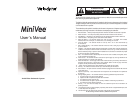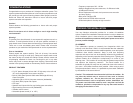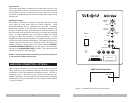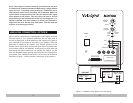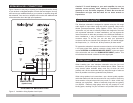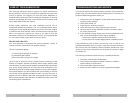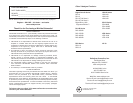
Regardless of where you install your Velodyne subwoofer, it must remain
in an upright position (woofer facing forward). Using, shipping or storing
the subwoofer in any other position for an extended period of time may
result in damage to the unit not covered by warranty.
Your new Velodyne subwoofer, like any good speaker system, requires
proper positioning within the listening space to provide maximum
performance. Improperly placed speakers may degrade the sound
quality and reduce your listening pleasure. Depending on the size and
type of furnishings in the room, perfect placement may not be possible.
Finding the best location within your environment will likely require some
experimentation. We suggest you experiment with the location during
setup to find what sounds best to you when seated in your typical
listening position.
INSTALLATION
Inputs
Your new subwoofer is equipped with speaker-level and line-level inputs.
Use the LINE LEVEL jacks when connecting your subwoofer to a pre-
amp, signal processor, line-level crossover or receiver with pre-amp
level outputs. The SPEAKER LEVEL jacks connect directly to the
speaker outputs of any amplifier, integrated amplifier or receiver. Your
amplifier section will notice no additional loading effects when you use
these inputs due to their very high impedance.
Important!!!
Do not use both LINE LEVEL and SPEAKER LEVEL
connections simultaneously!
Volume Control
This control allows you to balance the output from the subwoofer to the
main speakers/amplifier in your system. This control should be set to
achieve similar output level from both the main speakers and subwoofer
when listening to music. A good starting point for the volume control is 3
or 4 dots from minimum.
Low-pass Crossover - 40 to 120 Hz
All inputs sum the left and right channels together, with the resulting
signal p
assing through an adjustable low-pass crossover before being
amplified.
The crossover control allows you to adjust the upper limit of
the subwoofer
’s frequency response from 40 to 120 Hz. The
4
subwoofer’s response will begin rolling off above the frequency you set
this control to. You should set the crossover frequency to obtain a
smooth and seamless transition from the subwoofer to the main
speakers in your system. If your main speakers are smaller units with
limited low frequency output, you may wish to choose a higher frequency
(such as 100-120 Hz) than you would with larger speakers which have
greater low frequency output. With larger speakers, you might start with
this control set lower, such as 80 Hz.
A bypass switch is also provided if you wish to use an external
crossover. If you are not using an external crossover, we
recommend that you use the one provided within the unit for
optimum performance!
Phase Adjustment - 0°/180°
This control allows you to “reverse” the phase of the subwoofer’s output
signal 180° to correct for any possible mismatch and resulting
cancellation between the subwoofer and your main speakers/amplifier.
To adjust, simply listen to the system with music playing. Then move the
switch from one position to the other and listen for a change in low
frequency output. The correct position will have a greater amount of
apparent low frequency output.
Crossover Switch - INTERNAL X-OVER/SUBWOOFER DIRECT
This switch allows the internal crossover circuitry to be removed from the
signal path. This is required in certain installations which route the signal
through external processors with a crossover circuit of their own, such
as the new digital units. Simply move the switch to SUBWOOFER
DIRECT to disengage the built-in crossover. For all other installations
which do not have a separate electronic crossover, we recommend
you leave the switch set to INTERNAL X-OVER to provide
optimum performance.
Auto Turn on Function
With this function in the “auto” position, your subwoofer can be safely left
with the main power switched on continuously. The subwoofer will turn
itself on automatically when an audio signal is present. If no signal is
present for approximately 10 minutes, the unit will switch to standby
mode. While in standby mode, your subwoofer will draw very minimal
power. This function can be disabled by leaving the switch in the
“on” position.
5



